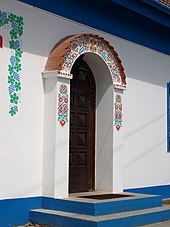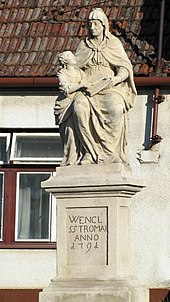Svatobořice-Mistřín
| Svatobořice-Mistřín | ||||
|---|---|---|---|---|
|
||||
| Basic data | ||||
| State : |
|
|||
| Region : | Jihomoravský kraj | |||
| District : | Hodonín | |||
| Area : | 2311 ha | |||
| Geographic location : | 48 ° 59 ' N , 17 ° 5' E | |||
| Height: | 193 m nm | |||
| Residents : | 3,538 (Jan 1, 2019) | |||
| Postal code : | 696 04 | |||
| traffic | ||||
| Street: | Kyjov - Čejč | |||
| structure | ||||
| Status: | local community | |||
| Districts: | 2 | |||
| administration | ||||
| Mayor : | František Měchura (as of 2008) | |||
| Address: | Hlavní 1000 696 04 Svatobořice |
|||
| Municipality number: | 586625 | |||
| Website : | www.svatoborice-mistrin.cz | |||
Svatobořice-Mistřín (German Swatoborschitz-Mistrzin ) is a municipality in the Czech Republic . It was created in 1964 through the merger of the municipalities Svatobořice and Mistřín. Svatobořice-Mistřín is located three kilometers southwest of Kyjov in Moravian Slovakia and belongs to the Okres Hodonín . From September 17, 1942 to April 12, 1945 there was a concentration camp assembly camp in Svatobořice .
geography
The South Moravian wine village Svatobořice-Mistřín is located in the Dolnomoravský úval , the Moravian part of the Vienna Basin , at the foot of the Záviště hill (255 m) on the right bank of the Kyjovka river . The road 422 from Kyjov to Čejč leads through the village , from which the 431 to Hodonín branches off in Mistřín . The disused railway line Kyjov- Mutěnice runs east of the village on the left of the Kyjovka .
Neighboring towns are Sobůlky in the north, Kyjov in the northeast, Skoronice in the east, Milotice in the southeast, Dubňany and Jarohněvice in the south, Šardice in the southwest and Stavěšice and Strážovice in the northwest.
history
Mistřín
The first documentary mention of Mistřín was in 1228 by Ottokar I. Přemysl in the course of granting privileges to the Velehrad monastery . In 1265 the village was mentioned under the name Mistersingen . This village was located one kilometer northwest of today's place in a place called Staré Mistříny . In the second half of the 15th century, the village fell desolate during the armed conflict over the Bohemian crown and the conquest of Moravia by Matthias Corvinus . The name of the village is derived from the Bulgarian name Mitrov. According to a legend, which ascribes the consecration of the church to the apostles Cyril and Method , the place name is said to have developed from the saying "To jsou opravdoví mistři".
In 1524 Wilhelm von Kunstadt acquired the desert goods from Mistřín and merged them with Svatobořice. In 1536 the village "Nový Mistřín" was mentioned for the first time, its location around the old church is assumed. The village was owned by the Zástřizl- Mistřín family for a long time . During the Hungarian uprising against the Habsburgs on June 1, 1605, insurgents invaded Nový Mistřín and burned the village. The place was destroyed again in the Thirty Years War. When the place was rebuilt around 1656, the residents chose a new location between Staré Mistříny and Nový Mistřín . In 1687 the line of the Zástřizl on Mistřín in the male line went out. The owner of the Mistřín estate was Franz Kolowrat -Liebsteinsky.
The new church was consecrated on July 2, 1743. In 1784 the old Romanesque church that stood south of Mistřín / Mistrzin on the square now known as “Na Kostelíkách” was torn down.
After the abolition of patrimonial Mistřín formed a community in the Kyjov / Gaya district from 1850. In 1888 the Counts Seilern acquired the Mistřín property. In 1924 the large estates were parceled out. Lignite was extracted in the hills west of the village . In 1960 the Okres Kyjov was dissolved and Mistřín assigned to the Okres Hodonín. In 1964 the merger with Svatobořice took place.
Svatobořice

Svatobořice was first mentioned in 1349 in the course of the sale of part of the village by Bolek von Otaslavice to Markvart von Morkovice . It is believed that Svatobořice is older than Mistřín. According to old legends, the town "Červené Město" once stood on the site of Svatobořice. In 1415 Jan von Moravany was named as the owner. There was a fortress in Svatobořice, which died out during the Hussite Wars and was rebuilt at the end of the 15th century. In 1460 Jan von Milotice was the owner of Svatobořice. He was followed by Jan von Ludanice. After his death, his brothers sold the village to Wilhelm von Kunstadt in 1522 , who also bought Mistřín in 1524 and united the two lords. After that, Svatobořice belonged to the family from Zástřizl on Mistřín. The owner of Svatobořice, Bohuš Morkovský ze Zástřizl, had the fortress redesigned into a renaissance castle in 1580, which was later redesigned in Baroque style. In 1583, the rule included the villages of Svatobořice, Nový Mistřín and Stavěšice as well as part of Sobůlky and the desert village of Jiříkovice. In 1687 the line of the Zástřizl on Mistřín in the male line went out. His widow and heiress, Zuzana Kateřina (1637-1691), married 23-year-old Walther von Dietrichstein in the same year as a second marriage . After Zuzana Kateřina's death, Count Karl Maximilian von Thurn and Count Franz Karl Libštejnský von Kolowrat jointly inherited the rule of Svatobořice. They sold it in 1692 for 50,000 guilders to the widow Ernestine Barbara Serényi, née von Löwenstein, in Milotice . In the same year, she left the rulership to her son, Chief Chamberlain Karl Anton Count Serényi, who struck Svatobořice zu Milotice and assigned it to the estate administration there. The no longer inhabited castle was converted into a brewery. In the center of the village there was a gate of a medieval fortification until the 18th century. After the abolition of patrimonial Svatobořice / Swatoborschitz formed from 1850 a community in the Kyjov / Gaya district.
Between 1899 and 1900, the Brno Local Railway Company built the Kyjov-Mutěnice / Gaya-Mutienitz local railway with which Svatobořice received a railway connection as a connecting line to the Saitz – Czeicz – Göding lines . In 1960 the Okres Kyjov was dissolved and Svatobořice assigned to the Okres Hodonín.
Svatobořice barracks camp
During the First World War, a barrack camp for refugees from Galicia was built in Svatobořice . After its dissolution, the barrack colony served as an infirmary and quarantine for emigrants from the 1920s . According to the Munich Agreement , the barracks served the refugees (Czechs, Jews, German democrats) from the occupied territories. During the Second World War, on September 17, 1942, a German concentration camp with the code name "Polaris-Centrum" was set up in the Swatoborschitz barrack colony. In the "SS internment camp for foreign transport prisoners" mainly Jews of Czech and German nationality from Czechoslovakia were held, but also political prisoners and Sinti and Roma who had fled abroad from the German occupiers and fell into the hands of the National Socialists had fallen. The camp was occupied by an average of 1200 prisoners. Until the liberation of the camp by the Red Army on April 12, 1945, a total of 3,500 people were interned in Swatoborschitz. After the end of the war, the camp was used as a prison camp for German soldiers and later as an internment camp for Germans in the course of the expulsion . In the 1950s the camp again served the refugees, first from Greece . In October 2017, a museum on the history of the internment camp in Svatobořice with a memorial was opened.
Svatobořice-Mistřín
In 1964 the municipalities Svatobořice and Mistřín merged to form a municipality with the double name Svatobořice-Mistřín.
In 1993 lignite mining was stopped. Passenger traffic on the railway line 257 Kyjov-Mutěnice was stopped in 2005. The municipality is a member of the Nový Dvůr microregion.
Culture
Folklore traditions are maintained in the community. This took place both through the use of national costumes and through folk music. In Svatobořice-Mistřín the costume groups Podkověnka, Krušpánek and Lúčka, Slovak circle Svatobořice-Mistřín, a male chorus, the wind music ensemble consist Mistříňanka that Zimbelensemble Varmužová Cimbálová muzika and Cimbálová muzika Ladislav Pavlus and the Kirchenchor AMA .
One of the Moravian Wine Paths leads through Svatobořice-Mistřín.
Community structure
The municipality Svatobořice-Mistřín consists of the districts Mistřín ( Mistersing ) and Svatobořice ( Swatoborschitz ).
Sons and daughters of the church
- Vladimír Vašíček (1919–2003), painter born in Mistřín
Attractions
- Baroque Church of the Visitation of the Virgin Mary in Mistřín, consecrated in 1743
- Statue of St. Florian, created in 1745 by the Viennese sculptor Jakob Christoph Schletterer
- Sculptural group of St. Anna, 1791 by Andreas Schweigl created
- Group of statues of the Holy Trinity on the road to Dubňany, erected in the second half of the 18th century
- Two stone Janus heads from the middle of the 17th century at the entrance to the former manor, called svatoborské opice ("Svatobořice monkeys")
- Bell tower from 1719, it was repaired in 1996 and the sundial was reinstalled
- Museum and memorial for the Swatoborschitz concentration camp
Individual evidence
- ↑ Český statistický úřad - The population of the Czech municipalities as of January 1, 2019 (PDF; 7.4 MiB)
- ↑ L. Hošák, R. Šrámek, Místní jména na Moravě a ve Slezsku I, Academia, Praha 1970, II, Academia, Praha 1980th
- ↑ a b Jitka Gruntová, Jan Kux: Internační tábor Svatobořice u Kyjova
- ↑ http://www.jihomoravsky.kraj.cz/encyklopedie/objekty1.phtml?id=98195
- ↑ Archived copy ( Memento of the original from May 29, 2016 in the Internet Archive ) Info: The archive link was inserted automatically and has not yet been checked. Please check the original and archive link according to the instructions and then remove this notice.
- ↑ January Kux: Internační tábor Svatobořice . Svatobořice-Mistřín-Brno 1995
- ↑ a b c Markus Pape: 75 let po zřízení tábora bylo otevřeno muzeum tábora Svatobořice - proč to trvalo tak dlouho? Romea.cz, October 9, 2017
- ↑ More information on the municipality's website





